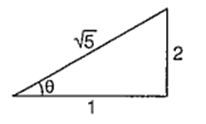 Multiple Choice Questions
Multiple Choice QuestionsA particle is projected with a velocity v so that its horizontal range twice the greatest height attained. The horizontal range is
A.
Given, a particle having honzontal range is twice the greatest height attained by it, i.e,

The velocity-time graph for two bodies A and B are shown in figure. Then, the acceleration of Aand B are in the ratio

sin 25° to sin 50°
tan 25° to tan 40°
cos 25° to cos 50°
tan 25° to tan 50°
The ratio of the dimensions of Planck's constant and that of moment of inertia has the dimensions of
angular momentum
time
velocity
frequency
Moment of inertia of a thin uniform rod rotating about the perpendicular axis passing through its centre is I. Ifthe same rod is bent into a ring and its moment of inertia about its diameter is I', then the ratio is
If the mass of a body is M on the surface of the Earth, the mass of the same body on the surface of the Moon is
6 M
zero
M
A stone of mass 0.05 kg is thrown vertically upwards. What is the direction and magnitude of net force on the stone during its upward motion ?
0.98 N vertically downwards
0.49 N vertically downwards
9.8 N vertically downwards
0.49 N vertically upwards
The ratio of kinetic energy to the potential energy of a particle executing SHM at a distance equal to half its amplitude, the distance being measured from its equilibrium position is
2 : 1
3 : 1
8 : 1
4 : 1
1 g of ice is mixed with 1 g of steam. At thermal equilibrium, the temperature of the mixture is
50°C
0°C
55°C
100°C
